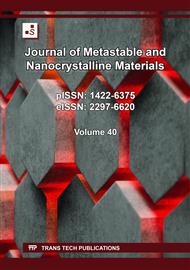[1]
S. Li, L. Zhou, H. Zhang, Investigation progresses of rare earth complexes as emitters or sensitizers in organic light-emitting diodes, Light Sci Appl., 11 (2022) 177.
DOI: 10.1038/s41377-022-00866-w
Google Scholar
[2]
L. U. Khan, Z. U. Khan, Rare Earth Luminescence: Electronic Spectroscopy and Applications. In: Sharma, S. (eds) Handbook of Materials Characterization. Springer, Cham. (2018) 345-404.
DOI: 10.1007/978-3-319-92955-2_10
Google Scholar
[3]
A. M. Konstantinidis, E. A. Lalla, G. Lopez-Reyes, U. R. Rodríguez-Mendoza, E.A. Lymer, J. Freemantle, M. G. Daly, Statistical learning for the estimation of Judd-Ofelt parameters: A case study of Er3+: Doped tellurite glasses, Journal of Luminescence, 235 (2021) 118020.
DOI: 10.1016/j.jlumin.2021.118020
Google Scholar
[4]
S. Shukla, D. K. Sharma, A review on rare earth (Ce and Er)-doped zinc oxide nanostructures, Materials Today: Proceedings, 34(3) (2021) 793-801.
DOI: 10.1016/j.matpr.2020.05.264
Google Scholar
[5]
S. Kumar, P. D. Sahare, Nd-doped ZnO as a multifunctional nanomaterial, Journal of Rare Earths. 30 (2012) 761-768.
DOI: 10.1016/s1002-0721(12)60126-4
Google Scholar
[6]
J. P. Singh, S. Pal, Y. K. Sharma, A. Nag, Nd-doped CdS nano-particles: Optical band gap and Urbach energy investigations, Journal of Optics, 2024.
DOI: 10.1007/s12596-024-01746-9
Google Scholar
[7]
J. Urban, S. K. Haram, S. W. Gosavi, S. K. Kulkarni, Synthesis and analysis of ZnO and CdSe nanoparticles, Pramana. 65 (2005) 615-620.
DOI: 10.1007/bf03010449
Google Scholar
[8]
U. Koch, A. Fojtik, H. Weller, A. Englein, Photochemistry of semiconductor colloids. Preparation of extremely small ZnO particles, fluorescence phenomena and size quantization effects, Chem. Phys. Lett. 122 (1985) 507-510.
DOI: 10.1016/0009-2614(85)87255-9
Google Scholar
[9]
S. Pal, Y. K. Sharma, Spectral, Structural and Characterization of Neodymium Ions Doped Zinc Oxide Nanomaterial, American Journal of Nanoscience. 7 (2021) 49-53.
Google Scholar
[10]
K. S. Shukla, E. S. Agorku, H. Mittal, A. K. Mishra, Synthesis, characterization and photoluminescence properties of Ce3+-doped ZnO-nanophosphors, Chemical Papers. 68 (2014) 217-222.
DOI: 10.2478/s11696-013-0442-5
Google Scholar
[11]
B. J. Chen, X. W. Sun, C. X. Xu, B. K. Tay, Growth and characterization of zinc oxide nano/micro-fibers by thermal chemical reactions and vapor transport deposition in air, Physica E: Low-dimensional Systems and Nanostructures. 21 (2004) 103-107.
DOI: 10.1016/j.physe.2003.08.077
Google Scholar
[12]
Y. K. Sharma, J. P. Singh, S. Pal, A. Nag, Fluorescence Study of Pr3+ doped CdS nanoparticles and its Applications in Sensors and Detectors, Journal of Fluorescence. 34 (2024) 915-923.
DOI: 10.1007/s10895-023-03325-w
Google Scholar
[13]
R. R. Jacobs, M. J. Weber, Dependence of the 4F3/2 → 4I11/2 Induced-Emission Cross Section for Nd3+ on Glass Composition, IEEE J. Quantum Electron. 12 (1976) 102.
Google Scholar
[14]
P. X. Gao, Z. L. Wang, Nanopropeller arrays of zinc oxide, Appl. Phys. Lett. 84 (2004) 2883-2885.
DOI: 10.1063/1.1702137
Google Scholar
[15]
S. Boruah, S. Mustafiza, D. Saikia, J. H. Saikia, P. P. Saikia, K. M. Baruah, Synthesis of ZnO Nanoparticles from Zinc Formate and Their Optical Properties, American Chemical Science Journal. 11 (2016) 1-10.
DOI: 10.9734/acsj/2016/22660
Google Scholar
[16]
E. A. Lalla, M. Konstantinidis, I. De Souza, M. G. Daly, I. R. Martín, V. Lavín, U. R. Rodríguez-Mendoza, Judd-Ofelt parameters of RE3+-doped fluorotellurite glass (RE3+= Pr3+, Nd3+, Sm3+, Tb3+, Dy3+, Ho3+, Er3+, and Tm3+), Journal of Alloys and Compounds. 845 (2020) 156028.
DOI: 10.1016/j.jallcom.2020.156028
Google Scholar
[17]
B. R. Judd, Optical Absorption Intensities of Rare-Earth Ions, Phys. Rev. 127 (1962) 750.
DOI: 10.1103/physrev.127.750
Google Scholar
[18]
G. S. Ofelt, Intensities of Crystal Spectra of Rare‐Earth Ions, J. Chem. Phys. 37 (1962) 511-520.
DOI: 10.1063/1.1701366
Google Scholar
[19]
P. Goyal, Y K. Sharma, S. Pal, U. C. Bind, Shu-Chi Huang, Shyan-Lung Chang, The effect of SiO2 Content on structural, physical and spectroscopic properties of Er3+doped B2O3-SiO2-Na2O-PbO-ZnO Glass system, J. Non-cryst Solids. 463 (2017) 118-127.
DOI: 10.1016/j.jnoncrysol.2017.03.009
Google Scholar
[20]
W. Luo, J. Liao, R. Li, X. Chen, Determination of Judd-Ofelt Intensity Parameters from the Excitation Spectra for Rare-Earth Doped Luminescent Materials, Physical chemistry chemical physics, 12 (13) (2010) 3276-3282.
DOI: 10.1039/b921581f
Google Scholar
[21]
P. Psuja, D. Hreniak, W. Strek, Rare-Earth Doped Nanocrystalline Phosphors for Field Emission Displays, Journal of Nanomaterials. (2007).
DOI: 10.1155/2007/81350
Google Scholar
[22]
K. Sahu, A. Ali, A. K. Kar, Altering the Photoluminescence Emission Quenching and Energy Transfer for the Photocatalytic Behaviour of ZnO Nanostructures, ECS Journal of Solid State Science and Technology. 11 (2022) 086003.
DOI: 10.1149/2162-8777/ac8ba7
Google Scholar
[23]
N. Joudeh, D. Linke, Nanoparticle classification, physicochemical properties, characterization, and applications: a comprehensive review for biologists, J Nanobiotechnol. 20 (2022) 262.
DOI: 10.1186/s12951-022-01477-8
Google Scholar
[24]
M. Blume, A. J. Freemen, R. E. Watson, Theory of Spin-Orbit Coupling in Atoms. III, Physical Review A, 134 (1964) A320.
DOI: 10.1103/physrev.134.a320
Google Scholar
[25]
G. H. Dieke, Spectra and Energy Levels of Rare Earth Ions in Crystals, in: H. M. Crosswhite, H. Crosswhite (Eds.), Interscience Publishers, New York, 1968.
Google Scholar
[26]
W. F. Krupke, Radiative transition probabilities within the 4f3 ground configuration of Nd:YAG, J. Quantum Electron. 7 (1971) 153.
Google Scholar
[27]
W. F. Krupke, Induced Emission Cross Sections in Neodymium Laser Glasses, IEEE J. Quantum Electron. 10 (1974) 450-457.
DOI: 10.1109/jqe.1974.1068162
Google Scholar
[28]
R. Balda, J. Fernandez, A. Mendioroz, J. L. Adams, B. Boulard, Temperature-dependent concentration quenching of Nd3+ fluorescence in fluoride glasses, J. Phys.: Condens. Matter. 6 (1994) 913.
DOI: 10.1088/0953-8984/6/4/011
Google Scholar
[29]
B. Denker, P. Fjodorow, M. Frolov, B. Galagan, V. Koltashev, V. Plotnichenko, M. Sukhanov, S. Sverchkov, A. Velmuzhov, Rare-Earth-Doped Selenide Glasses as Laser Materials for the 5–6 μm Spectral Range, Photonics. 10 (2023) 1323.
DOI: 10.3390/photonics10121323
Google Scholar
[30]
D. Sharma, J. Rajput, B. S. Kaith, M. Kaur, S. Sharma, Synthesis of ZnO nanoparticles and study of their antibacterial and antifungal properties, Thin Solid films. 519 (2010) 1224.
DOI: 10.1016/j.tsf.2010.08.073
Google Scholar


